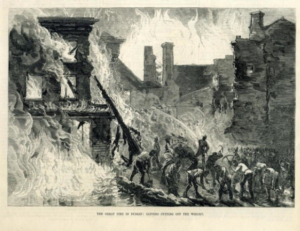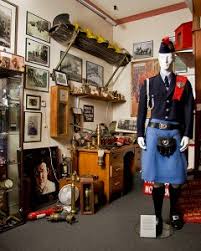The Great Whiskey Fire 1875
 When and where the fire happened:
When and where the fire happened:
The Great Whiskey Fire took place on the 18th of June in the year of 1875 at 8pm. The fire started in Malone’s bonded warehouse and Reed’s Malthouse on Chambers Street in the heart of the Liberties and the Coombe area of Dublin. Mr. Laurence Malone owned the warehouse. It was estimated that there were 7,800 barrels of whiskey in these warehouses. The fire spread between Ardee St. and Cork St. and destroyed everything in between.
What happened on the streets during the fire?
The fire quickly spread to adjoining buildings and burning whiskey started to flow down the street like burning lava. All the horses and pigs in the area stampeded down the street and caused panic and havoc. You can imagine the noise and confusion added to the panic. People were forced to leave their homes. The newspapers reported afterwards that the army and the police helped people to save some of their furniture by moving it out of the burning buildings. People attending a wake were forced to leave and bring the corpse with them. Thousands of people came out to watch the fire from all over Dublin. A nearby Carmelite Convent was in danger of being engulfed by the flames but was saved by the wind direction. But the wind blew the fire into some of the nearby tenement houses.
When the fire brigade arrived – what did they do?
The fire brigade arrived and were led by Captain James Robert Ingram, who was the Chief Fire Officer. He had a lot of experience, having worked in the fire service in America. He was a very innovative person, for example he sent the Navy out into Dublin Bay to blow up a burning ship and sink it before it came into the port.
Water was first used to extinguish the fire but it only made it worse. Then the fire brigade, with the assistance of the army, tried using sand and gravel which didn’t work either. Captain Ingram then called on Dublin Corporation to gather all the horse manure in the area, which there was plenty of. He asked the Army to help spread the manure to create a barrier to stop the fire spreading. It eventually put the fire out.
The aftermath – deaths, cost of fire:
When the firemen were putting out the fire, people filled their hats, boots and any other container with whiskey, which was contaminated with manure and sewage. What started out as panic had turned into a party. For example two young 21 year olds from Bow Street in Dublin’s north inner city went over to have a look at the fire. They saw the whiskey flowing down through the Coombe and helped themselves to some of it. Actually they helped themselves to a great deal of it! One of the lads fell into a coma and died a couple of days later in the Richmond Hospital. He died of alcohol poisoning. Thirteen people died in the fire as a result of alcohol poisoning, no one died from the actual fire!
There was £150,000 (€8 million in today’s value) worth of damage caused by the fire. Not everybody was covered by insurance, especially the people living in the tenements. They were left homeless after the fire. Even Mr. Malone, who owned one of the warehouses and who was insured, had not enough insurance to cover his losses.
The newspapers reported it as the biggest fire of the 19th century in Dublin.
Captain Ingram:
There isn’t a lot of information known about Captain James Ingram, who was the first fire chief of the Dublin Fire Brigade. We do know that he brought back a lot of knowledge about how to run a fire service based on his experience in America. For example he brought back some actual uniforms from the American fire service and these were the first uniforms the Dublin Fire Brigade had.
We also know that he got married in 1866 to a lady named Emma Thompson. We don’t know if they had any children.
Captain Ingram died in 1882 at the age of 52 from tuberculosis. He is buried in an unmarked grave in Mount Jerome cemetery in Harold’s Cross. The Dublin Fire Brigade have tried to erect a proper headstone in memory of him but due to a lot of red tape they have had no success so far.
Written jointly by:
Pat Fitzpatrick
Mary McCabe
Elizabeth Boland
Nikita Dunne
Angela Gannon
Joe Keogh
Jack Gilligan
Peter Timmons
Question 2
If this fire happened today, would it have as great an impact on the city? Think about this under the following headings: loss of life, loss of property, fire brigade resources and government/charitable support.
If you want to write your answers please do.
If you would like to create something about the Whiskey Fire – a drawing, painting, poem, song, anything! Please do.
 4. Visit
4. Visit
Find out how you can visit The Dublin Fire Brigade Museum here: http://www.dfbexternaltraining.ie/dfb-museum/









